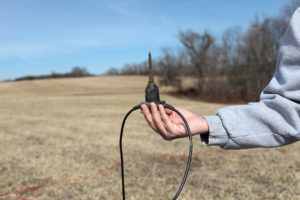All Categories
Featured
Table of Contents
Geophysical Surveys For Planning & More in Kewdale WA 2021

The primary design for the radial structure of the interior of the Earth is the initial referral Earth design (PREM). Some parts of this model have been upgraded by recent findings in mineral physics (see post-perovskite) and supplemented by seismic tomography. The mantle is generally composed of silicates, and the limits between layers of the mantle follow stage transitions.

This makes plate tectonics possible. Schematic of Earth's magnetosphere. The solar wind circulations from left to right. If a planet's electromagnetic field is strong enough, its interaction with the solar wind forms a magnetosphere. Early space probes mapped out the gross measurements of the Earth's magnetic field, which extends about 10 Earth radii towards the Sun.
Inside the magnetosphere, there are fairly dense regions of solar wind particles called the Van Allen radiation belts. Geophysical measurements are generally at a specific time and place.
What Does A Geologist Do? in Forrestdale Aus 2021
A three-dimensional position is calculated using messages from four or more visible satellites and referred to the 1980 Geodetic Referral System. An alternative, optical astronomy, combines huge collaborates and the local gravity vector to get geodetic coordinates. This technique only provides the position in two collaborates and is harder to use than GPS.
Gravity measurements became part of geodesy since they were required to related measurements at the surface of the Earth to the referral coordinate system.
Satellites in area have made it possible to collect data from not just the noticeable light area, but in other locations of the electromagnetic spectrum. The worlds can be characterized by their force fields: gravity and their magnetic fields, which are studied through geophysics and area physics. Determining the changes in acceleration experienced by spacecraft as they orbit has allowed great details of the gravity fields of the worlds to be mapped.
Course: Basics In Geophysical Surveying in Samson Aus 2022

Since geophysics is concerned with the shape of the Earth, and by extension the mapping of features around and in the planet, geophysical measurements consist of high accuracy GPS measurements. When the geophysical measurements have actually been processed and inverted, the translated results are plotted using GIS.
Numerous geophysics companies have designed internal geophysics programs that pre-date Arc, GIS and Geo, Soft in order to meet the visualization requirements of a geophysical dataset. Exploration geophysics is applied geophysics that frequently uses remote picking up platforms such as; satellites, aircraft, ships, boats, rovers, drones, borehole noticing equipment, and seismic receivers.
Aeromagnetic data (airplane gathered magnetic data) collected using standard fixed-wing aircraft platforms must be remedied for electromagnetic eddy currents that are created as the aircraft moves through Earth's magnetic field. There are also corrections related to modifications in determined potential field intensity as the Earth turns, as the Earth orbits the Sun, and as the moon orbits the Earth.
Consumer Guide To Geological And Geophysical Services ... in Oakford Oz 2021
Signal processing includes the correction of time-series information for undesirable sound or mistakes introduced by the measurement platform, such as aircraft vibrations in gravity data. It also involves the decrease of sources of noise, such as diurnal corrections in magnetic data. In seismic information, electromagnetic data, and gravity information, processing continues after error corrections to consist of computational geophysics which lead to the last interpretation of the geophysical information into a geological analysis of the geophysical measurements Geophysics emerged as a separate discipline just in the 19th century, from the crossway of physical location, geology, astronomy, meteorology, and physics.
The magnetic compass existed in China back as far as the fourth century BC. It was used as much for feng shui as for navigation on land. It was not up until good steel needles could be forged that compasses were utilized for navigation at sea; prior to that, they could not retain their magnetism long enough to be useful.
By taking a look at which of 8 toads had the ball, one could determine the direction of the earthquake. It was 1571 years before the very first style for a seismoscope was released in Europe, by Jean de la Hautefeuille. It was never developed. One of the publications that marked the start of modern-day science was William Gilbert's (1600 ), a report of a series of meticulous experiments in magnetism.
Geophysical Surveys in Attadale Aus 2022
Dietmar; Sdrolias, Maria; Gaina, Carmen; Roest, Walter R. (April 2008). "Age, spreading out rates, and spreading asymmetry of the world's ocean crust". Geochemistry, Geophysics, Geosystems. 9 (4 ): Q04006. Bibcode:2008 GGG ... 9. 4006M. doi:10. 1029/2007GC001743. S2CID 15960331. "Earth's Inconstant Electromagnetic field". science@nasa. National Aeronautics and Space Administration. 29 December 2003. Obtained 13 November 2018.
Leipzig. Berlin (Gebruder Borntraeger). Runcorn, S.K, (editor-in-chief), 1967, International dictionary of geophysics:. Pergamon, Oxford, 2 volumes, 1,728 pp., 730 fig Geophysics, 1970, Encyclopaedia Britannica, Vol. 10, p. 202-202 Ross 1995, pp. 236242 Shearer, Peter M. (2009 ). Introduction to seismology (2nd ed.). Cambridge: Cambridge University Press. ISBN 9780521708425. Stphane, Sainson (2017 ).
Latest Posts
Geophysical Survey in Jandakot Australia 2020
Geophysics Definition & Meaning in Roleystone Oz 2021
Geophysical Survey - Explore The Seafloor in Kinross WA 2021